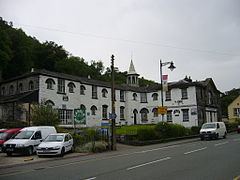Population 2,325 (2011) Community Corwen Country Wales Local time Monday 9:17 PM Ceremonial county Clwyd | OS grid reference SJ075435 Principal area Denbighshire Sovereign state United Kingdom Dialling code 01490 UK parliament constituency Clwyd South | |
 | ||
Weather 4°C, Wind W at 11 km/h, 89% Humidity | ||
The crown inn nr corwen travel vlog vantastic welsh wildcamping
Corwen is a town, community and electoral ward in the county of Denbighshire in Wales; it was previously part of the county of Meirionnydd. Corwen stands on the banks of the River Dee beneath the Berwyn mountains. The town is situated 10 miles (16 km) west of Llangollen and 13 miles (21 km) south of Ruthin. At the 2001 Census, Corwen had a population of 2,398, reducing to 2,325 at the 2011 census.
Contents
- The crown inn nr corwen travel vlog vantastic welsh wildcamping
- Map of Corwen UK
- Pet friendly holiday cottage in corwen north wales
- History
- Economy
- Transport
- Culture
- References
Map of Corwen, UK
Pet friendly holiday cottage in corwen north wales
History
Corwen is best known for its connections with Owain Glyndŵr, who proclaimed himself Prince of Wales on 16 September 1400, from his nearby manor of Glyndyfrdwy, which began his fourteen-year rebellion against English rule. A life-size bronze statue of the prince mounted on his battle horse was installed in The Square in 2007. It commemorates the day he was proclaimed the last true Prince of Wales in 1400.
The town grew as a centre for cattle drovers. Attractions in Corwen include the motte of a Norman castle, the thirteenth century Church of St Mael and St Sulien and the Capel Rûg built in 1637 by William Salesbury.
Corwen Golf Club (now defunct) was founded in 1909. The club closed at the onset of WW2.
Economy
Located in the hills of north Wales, the main economy of Corwen is based in and around farming. The town's main employer is local trailer manufacturer Ifor Williams Trailers, started by a farmer looking to transport sheep to the local market.
Transport
In the 1860s Corwen was linked to the national rail network in 1864 by a line from Ruthin along the Vale of Clwyd and in 1865 with a Great Western Railway branch line along the Dee valley from Ruabon. The station was a vital development in the town's importance as the centre of the local Agriculture industry. Unfortunately neither survived the Beeching Axe in the 1960s. The town is now linked to the Llangollen Railway, with a temporary station, Corwen East (Welsh: Dwyrain Corwen), which opened on 22 October 2014. The permanent way had been extended into Corwen in late spring 2014, but work is still required to construct a new permanent Corwen railway station alongside the town's main car-park.
Bus services in Corwen were primarily provided by GHA Coaches with routes available to Wrexham via Llangollen on services 5 and T3, Barmouth via Bala and Dolgellau on service T3 (now operated by Lloyds Coaches), and to Ruthin on service X5 (now operated by Arriva Buses Wales), with through services continuing to Denbigh. Llew Jones operate a twice daily, weekday service to Llanrwst with one journey extended to/from Bala.
Corwen is the last sizeable town on the A5 road from London to Holyhead until Betws-y-Coed is reached. Because of this it still contains a number of hotels which were used in the past as coaching inns for the Mail coach and stagecoaches. Although the A5 is no longer the most important road to Holyhead, having been superseded by the coastal route of the A55, there is still significant traffic travelling through the town centre’s narrow main street.
Culture
Corwen hosted the National Eisteddfod in 1919. The Pavilion in the town has played an important part in Welsh culture throughout the 20th century. It has hosted several concerts and eisteddfodau. It was also the venue for the first concerts performed by Edward H. Dafis, the first Welsh-language rock band to receive significant press notice, in August 1973.
Novelist John Cowper Powys (1872-1963) lived in Corwen with his common-law wife Phyllis Playter from 1935 until 1955, when they moved to Blaenau Ffestiniog. He wrote two major novels both set in this region of Wales, while living in Corwen, Owen Glendower (1940) and Porius (1951), amongst other works of both fiction and non-fiction. In 1940 he began a novel set in contemporary Corwen but gave it up, to start his "Romance of Corwen", Porius, subtitled "a Romance of the Dark Ages", in January 1942, the action of which takes place in 499 A.D.
